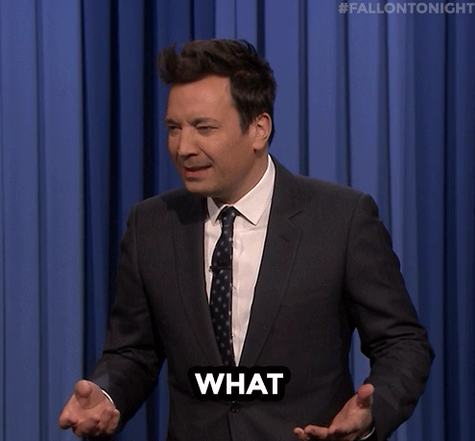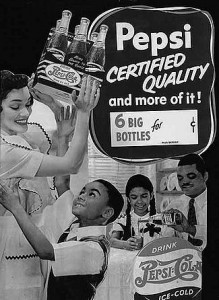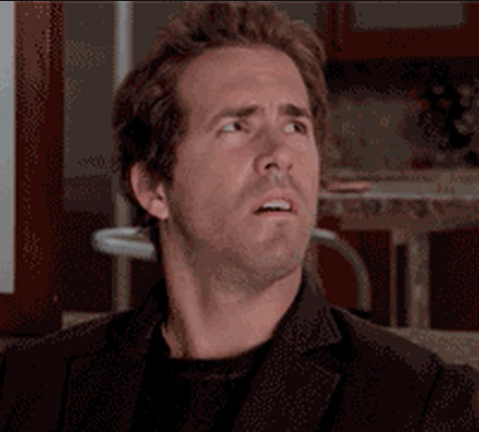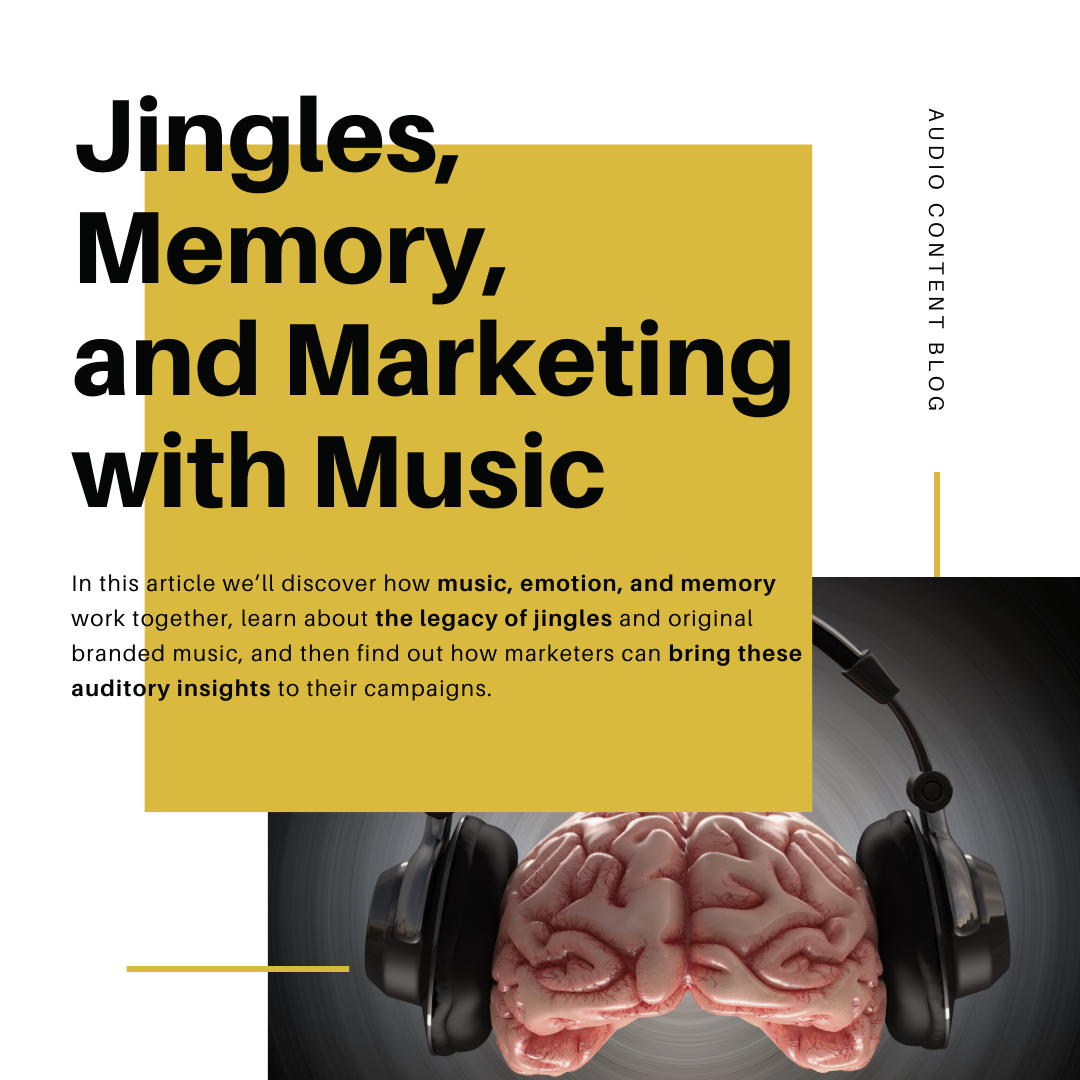In the quest to create salient, distinct, brand assets and advertising people will remember, marketers tend to focus on everything but the musical or auditory aspects of their campaigns, which science has shown are key factors in memory recollection.
In this article you’ll discover how music, emotion, and memory work together, learn about the legacy of jingles and original branded music, and then find out how to bring these auditory insights to your marketing campaigns.
The State of Music in Modern Marketing
Original music is usually the last thing marketers think about, but according to the kids on social media, and that furniture store jingle in your head from childhood, music is the first thing on everyone’s mind.
How is it, that after the success of “Hamilton,” and with sea shanties and crowd-sourced musicals currently flourishing on TikTok and Clubhouse, using jingles in advertising is derided as out-dated and corny?

Advertisers know that music is important.
Brands and agencies routinely fall over themselves to secure the million dollar rights to a Top 40 chart-topper, but the modern examples of extremely catchy, memorable, original jingles, are few and far between.
Why is that?
Jingles, Music, and Memory Recollection
Ever since the advent of music, some 30,000 years ago, humans have been singing songs about their lives and experiences. In the chain of human development, the ability to play and appreciate music, predates speech and agriculture.
Our ancestors knew that music was an essential part of what it means to be a human. In the last 500 years, since the rise of court musicians, there has been a decline in everyday musicianship.
Back in the day, everyone sang and played, because that’s what you did or else you went cannibal on each other. Only recently have we decided to let professional musicians handle the stuff, but the anthropological truth is that we are all inclined and predisposed to engage with, appreciate, and enjoy music.
In his brilliant TedTalk on marketing, music, and evolution, Dr. Ethan Decker, founder of Applied Brand Science, begins with an exercise of jingle recollection.
He starts to sing the beginning of a jingle, and asks the audience to finish it, and with regularity, the whole audience is able to sing back the ending of these original songs about insurance, toy stores, and hot dogs.
For most of us, music has a prominent, ubiquitous, role in our everyday lives. It could be for distraction, recreation, or mood enhancement; people like to listen to music.
And since music is everywhere, it’s been identified as an important piece to the way we define our lives, the way we craft our autobiographical memories of ourselves, and others.
Because emotions enhance memory processes and music evokes strong emotions, music is deeply involved in the process of memory formation.
Hearing music from our past evokes a strong ‘feeling of knowing,’ it sparks autobiographical associations, emotional information, but more than this, familiar musical cues can trigger semantic memories as well.
Short musical pieces with particular characteristics can prime the semantic language memory system, thereby yielding faster and more efficient recognition of specific words, and for our intents and purposes, branded taglines in jingle form.
If we look at the most common terms used in memory research, like Arousal, Associative Memory, Implicit and Explicit Memory, Emotional Valence, Priming, music is a triggering factor in all instances.
One of the more fascinating aspects of music and explicit VS implicit memory, is that even at low levels of attention, music is processed and linked with experience and events. Even if you think you ignore music playing in the background, your brain is processing it at a subliminal level.
Good news for TV advertisers!
For marketers looking to create memorable moments with their products or services, music is the perfect tactical choice. Our brains can’t help but process music, making it one of the sensory inputs that works automatically.
Since humans communicate through speech and generative language, our brains latch onto song fragments, melodies, and process them semantically in the brain’s auditory cortex and speech areas.
With music, expectations are established and manipulated through rhythm, which is processed through our brain’s limbic system.
And, as our prefrontal cortex processes a musical cue, narrative memories of episodes associated with those timbres, pitches, and rhythms, are all activated in concert with the stimulation.
So the way music sounds, the melodies, the rhythms, the taglines – all of these play with expectations and emotions and associations in the brain, creating this whole-brain party.
Now, with a firm grasp on how music positively impacts memory, how the modern marketplace is eager for audio bandwagons to jump on, let’s explore some powerful examples of effective jingles from the past.
Jingle Hall of History
Just like product marketers quest for the right combination of packaging, product, and labeling, to drive buyers to purchase, the musically inclined marketer might wonder if there are certain pitch combinations or orchestrations that can exact buyer behaviors.
In order for a jingle, or any style of branded communication, to be effective in a marketplace, it has to, in some way, mimic or aggravate the desires, affect, taste, and temperament, of the musical experiences the target audience is immersed in and engaged with at a popular level.
It has to be familiar, but novel. Recognizable, but fresh. You have to do something different, with cliche.
And that’s why branded music, or jingles, have been the go-to choice for marketers looking to interface with the general population in relatable ways for hundreds of years!
Let’s start close to the beginning.
1906 – “In My Merry Oldsmobile” – Written by Gus Edwards & Vincent Bryan, the song’s chorus is one of the most enduring automobile-oriented themes, being used by the brand in various forms in it’s marketing for over 50 years!
They sold sheet music for this. The chorus has been adopted by popular culture as well, being quoted in M*A*S*H, on 1979 UK rockabilly records, and used as an intro for a 2015 episode of the TechDirt podcast.
That’s 110 years of this song, permeating throughout popular culture. Is there another marketing asset that travels through time, quite like a jingle?
Musically speaking the piece reflected the eras predilection for waltzes, and as a piece of marketing material, had distribution through publishers and took advantage of mediums like phonograph records to help promote the jingle and brand.
Plus, the brand is in the chorus, the product is in the song, and the emotions associated with the whole affair are summed up in a “whistle-back” oom-pah waltz. It’s a slam dunk!
1926, “Have You Tried Wheaties?” by Henry Bellows
Alleged to be the first instance of a singing radio ad in America, and correlated by General Mills to be the sole reason the Wheaties brand lives on, the 1926 Wheaties jingle, “Have You Tried Wheaties?” is a cornerstone of jingle history.
The jingle was a last ditch effort by the General Mills VP, Donald Davis, to save Wheaties. Davis owned a newly minted radio station in Minneapolis, and he had no clue how to monetize it. So trying to hit all the birds with one rock, he hired a barbershop quartet to write, and perform the jingle live each week, on a Minnesota-based radio program, for three years.
In 1929, General Mills was thinking of scrapping Wheaties, when they noticed sales of the brand were way past 60% in the Minneapolis/St. Paul area, the exact place the jingle had been running.
Then, Samuel Gale from the advertising department rode in at the last minute and proposed an expansion of the jingle. “I believe that if the use of radio were extended to other territories,” Gale said, “these figures would be duplicated and that Wheaties need not be dropped.”
The board agreed, and Wheaties launched a national campaign. Sales soared.
One interesting side-note – the melody for the Wheaties jingle was an appropriation of the chorus from the 1919 hit tune, “Jazz Baby.”
Interesting to note how music, like other advertising disciplines, borrows heavily from the culture it seeks to impact. Indeed, the Wheaties jingle could be labeled a dope-ass remix. Nothing new under the sun, apparently.
1939, “Pepsi Cola Hits The Spot” by Austen Johnson and Alan Kent
As part of a broader initiative to expand into the Black American market, Pepsi had this jingle written and performed in a style fitting to the contemporary jazz hits of the day.

Vocal harmonies, a nice memorable melody, (which is actually a English hunting song, “Dye Ken John Peel” written in 1695!) good rhythm, and interesting use of onomatopoeic lyrics at the end with the “nickel/trickle” line. If you’re going for memorability, this song ticks all the boxes.
1950s “Raisin Bran” by Dick Marx
In this 1950s commercial for Post’s Raisin Bran, meet Maisie the Raisin and Jake the Flake. They tell the story of track star Hotfoot Harry. “Poor Harry’s so low that he can’t clear the hurdle—in fact, in this race, he got beat by a turtle.” But of course, “one bowl [of Post’s Raisin Bran] and Harry is back in the race, with a song in his heart and a smile on his face.”
Again, stylistically the cue matches the popular music of the day, and is performed to perfection. But it is the opinion of this musician and lyricist, that the density of words in this spot serve the music, and not the product. Perhaps the reason we haven’t heard much of these two early cereal mascots, is that they were buried under words, rather than memorable lyrics.
1962, “Oscar Mayer Weiner Song” by Richard Trentlage
Written in response to an open contest Oscar Mayer was running to identify jingles, Richard Trentlage was already an established jingle-smith from Illinois with several existing hits under his belt for clients like McDonald’s, V8, and the National Safety Council.
He wrote the jingle after observing his son pretending to be a stunt motorcycle rider in the backyard. He kept likening himself to a “dirt bike hot dog,” hot dog meaning ‘cool person.’ So Trentlage had the idea of making Oscar Mayer hot dogs, the ‘hot dog’ kids wanted to be.
Oscar Mayer used the jingle in their marketing for over 50 years, retiring it in 2010. Trentlage went on to collect substantial royalties until his death in 2016.
1969, “You Can Take Salem Out of The Country” by Steve Karmen
Written by The Jingle King, Steve Karmen, Salem’s signature jingle from the 60s-70s is a doozy of an earworm, and it’s due to a few simple twists of musical craftsmanship that play with our brains and expectations.
Karmen penned the jingle after meeting with the executives, one of which delivered the tagline, with a huge pause in the middle, which inspired the signature “ding” and pause, in the song.
Knowing what we do about music’s impact on our brains through melody and rhythm, the Salem jingle, and every jingle written by Steve Karmen, contains a subversion of expectation that catches in the mind, a sort of Zeigarnik Effect, where something that’s interrupted becomes easier to recall.
1970s-80s “Wehrenberg Theaters Jingle”
A legend in the St. Louis-area, this opened up every movie seen in the theater chain from the 70s-80s, and was updated in the 90s, keeping the melody.
I found a ton of comments and Reddits looking for this, pining for this, remembering better times. A ton of warmth coming off this one song.
Marcus Theaters, which bought up Wehrenberg, has made the jingle and all it’s versions available on their website, a great example of brands respecting their musical heritage.
1977-98 “Big Red Jingle” by Peter Cofield
Typically rated one of the most memorable jingles in the US, the Big Red commercials usually featured couples kissing in unlikely spots for lengthy amounts of time.
Wrigley updated the jingle in 2008 with Ne-Yo, giving the auditory meme a forty year lifespan! And that whole update the Wrigley jingles thing….
2008, “Forever” by Chris Brown, for Wrigley Doublemint Gum
Boy, this was a mess. When this song came out, it was not billed specifically as a commissioned work from Wrigleys, as detailed in this Wall Street Journal piece about the marketing stunt.
Wrigley’s pays to have it recorded in Feb, Jive records releases it in April, by July the song is #4 on the Billboard 100.
Then, in the fall, when Wrigley and the artists revealed it was all a build up to ad campaigns, there were unhappy people. Here’s a scathing section from a Gawker piece, by the enraged Hamilton Nolan, on the switch-n-bait jingle gate –
“This was all done in secret. Tomorrow the company holds a big press conference revealing the whole scam, presumably with the expectation that music fans will clap with delight and declare Wrigley to be their new favorite gum manufacturer. I would suggest that the more fitting response would be a bonfire of Doublemint, angry sloganeering, and boycotts of the company and Chris freaking Brown and his record label.”
Needless to say, people were unhappy, but the question should be, was all of it worth it for Wrigleys? Another open question, was how much Chris Brown was paid to write the song by Wrigley?
We’ll never know the answer. Not soon after this jingle, Chris Brown’s criminal behavior and exploits swallowed up the entertainer’s career, and with it, the campaigns and association’s brands had tied to his rising star.
2020, “Did Somebody Say? – Just Eat” by Snoop Dogg
Ending with a modern example, McCann London worked on this lighthearted spot, and delivered it to much aplomb. Here are some of the comments I saw on YouTube….
And so, it’s a kind of shock when the most recent news out of adland, was that Just Eat has put McCann into review and is looking at other ad agencies.

If the Dogg can’t deliver a jingle worth keeping past 6 months, perhaps the future of music and marketing resembles most crumbling industries today. Victims of procurement mentality, post-rationalized econometrics, and dwindling budgets.
In Conclusion
Music permeates our culture and lives, it’s an autobiographical glue that holds up memories of words and spaces, times and faces, feelings and fears, and through these emotional associations, we craft the narratives of our lives.
Branded musical moments, be they musicals or jingles or audio signatures, have a track record of hundreds of years of influencing culture, and music itself has thousands of years of evolutionary history influencing humanity.
Marketers and advertisers should pay attention, and listen, to the examples of music in their own lives, recognize it’s importance and impact, and take these considerations into the next campaign brainstorm.
The digital world of marketing is awash in tactics, but we have to ask ourselves how they connect with the audience? Well-crafted, branded music, aka jingles, are almost the perfect way to ensure a distinct and memorable connection with a branded message, takes place.
As David Ogilvy once famously said of jingles in advertising – “if you don’t have anything to say, sing it!” Perhaps that advice is still good today, or at least, there’s a ring of truth to it?
Interested to learn more about ways audio can help your brand connect with audiences? Get in Touch with Us!

